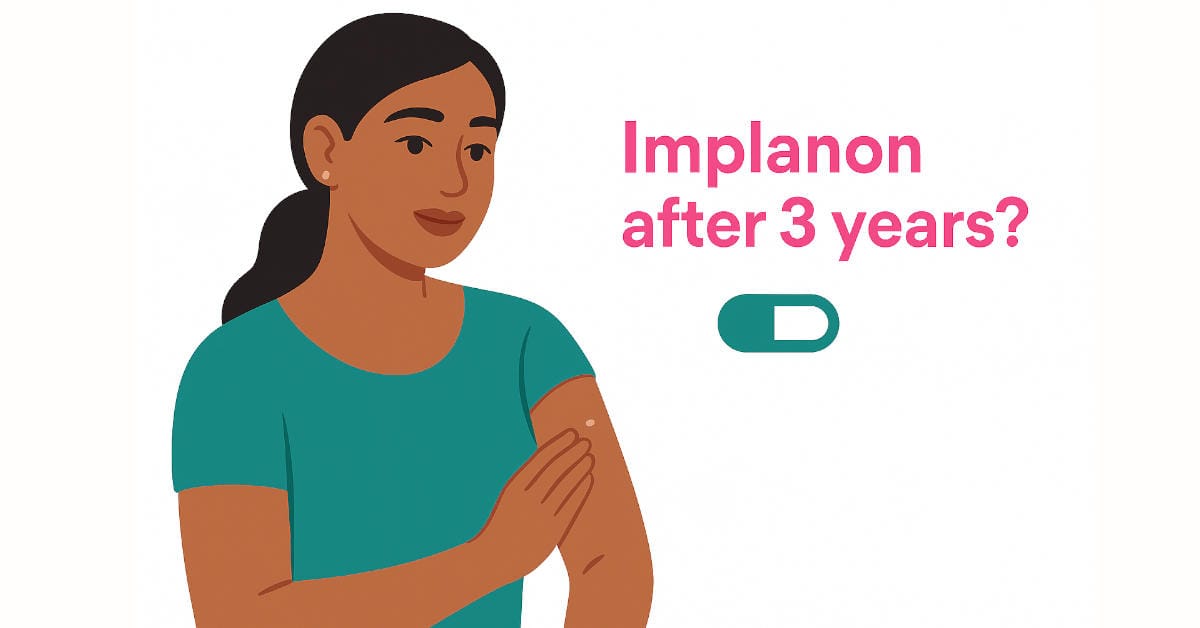The contraceptive implant is a small etonogestrel rod placed under the skin of the upper arm. Product labels in many countries say to replace it after 3 years of use. Several cohort studies have followed users for longer and have reported very low pregnancy rates in years four and five. Any decision to extend use beyond the labelled duration should be made with a clinician who knows your medical history and local guidance.
This article summarises what the research says about effectiveness after 3 years, how professional bodies interpret that evidence, and what practical questions you might discuss with your clinician. It does not recommend a specific course of action. Local product information, clinic protocols, and your own risk tolerance remain central.
What the evidence says
A WHO led cohort reported no pregnancies among users who kept the etonogestrel implant in place into years four and five. You can read the study here: Ali et al., Contraception 2016. The authors concluded that effectiveness remained very high during those extra years, while noting that the number of users who continued beyond 3 years was modest.
Other observational work has also found very low pregnancy rates when the implant remains in place past the labelled 3 year interval. These data suggest that hormone release and ovulation suppression do not stop suddenly at 3 years. Instead, protection appears to decline gradually, which is why researchers have been interested in the real world duration of use.
Professional guidance reflects these findings but differs by region. The American College of Obstetricians and Gynecologists notes effectiveness for at least 4 years and reports no pregnancies in one study through 5 years. UK guidance from FSRH recognises data with no pregnancies in extended years and emphasises counselling about off label extended use, including discussion of the small evidence base and local policy. In Australia, the etonogestrel implant is marketed as Implanon NXT and the current product information lists a 3 year duration.
Why labels and guidelines can differ
Product labels are based on the evidence that manufacturers submit to regulators at the time of approval. If early trials only followed users for 3 years, the approved duration on the label will match that time period. Later studies may extend beyond that window, but labels do not always change quickly even when more data become available.
Guidelines from professional bodies, on the other hand, can incorporate newer cohort studies and life table analyses. This is why you may see a difference between the official label duration and what some guidance documents say about possible extended use. Clinicians are allowed to use medicines off label when it is supported by evidence and local standards, but they are expected to explain the uncertainty and document those decisions.
What this means in practice
- If the implant is at or past 3 years and pregnancy would be unacceptable, replacing it on time is the most conservative option. This aligns with the duration printed in the product information.
- If access to replacement is delayed, talk with your clinician about temporary backup methods and whether short term extension is reasonable in your situation. Some services allow a limited grace period when replacement appointments are hard to obtain.
- Guidance from some professional bodies notes that weight alone is not a reason for early replacement, although data in people with very high BMI are limited. Your clinician may still factor body weight and other conditions into an individual plan.
- If you feel anxious about relying on off label duration, it may be more comfortable to use condoms or another backup method until you can replace the implant, even if the statistical risk appears low.
Estimate pregnancy risk during implant use
Use the Contraceptive Risk Calculator to see a per act estimate using “contraceptive implant (the rod)” and your age.
How the implant works, briefly
The rod releases etonogestrel, a progestogen. It mainly prevents ovulation and also thickens cervical mucus so that sperm are less likely to reach an egg. These effects are strongest soon after insertion and decline slowly over time as the hormone reservoir is used up.
In theory, as hormone levels fall, some ovulatory cycles could return before the label end date, and some users could still have suppressed ovulation after the label date. Real world studies that follow people over time help estimate how often ovulation resumes and how that translates into pregnancy rates in everyday use.
Questions to ask your clinician
If your implant is approaching or past 3 years, these questions may help structure a discussion:
- What does local guidance at this clinic say about extended use of the etonogestrel implant?
- How long do you usually consider the implant to remain highly effective in people my age and with my health background?
- Is there any reason in my medical history that would make extended use less suitable for me?
- If replacement cannot happen straight away, what backup methods do you recommend until it is changed?
Hearing how your own service interprets the evidence can help you decide whether you are comfortable continuing the current implant or prefer a strict 3 year replacement schedule.
Methodology and sources
- Ali M, et al. Extended use up to 5 years of the etonogestrel implant (Contraception, 2016): zero pregnancies reported in years 4 to 5 among study participants who continued the implant.
- ACOG Practice Bulletin on LARC: notes effectiveness for at least 4 years and cites a study with no pregnancies through 5 years.
- FSRH Clinical Guideline: Progestogen only implant (2021, updated): summarises cohorts with no pregnancies in extended years and advises counselling on off label use.
- CDC U.S. Selected Practice Recommendations summary (implants) (2024): implementation guidance on use of implants in clinical practice.
- TGA ARTG entry for Implanon NXT: Australian product information for the etonogestrel implant lists a 3 year duration.
This article is general information, not medical advice.
For broader context on methods and effectiveness, see Contraceptives and fertility.

